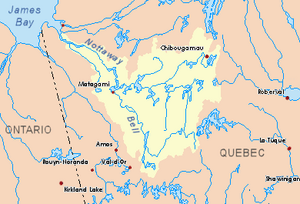Bell River (Quebec) facts for kids
Quick facts for kids Bell River |
|
|---|---|

Nottaway River's watershed
|
|
| Country | Canada |
| Province | Quebec |
| Region |
|
| Physical characteristics | |
| Main source | Lake Tiblemont Senneterre, Quebec, Abitibi-Temiscamingue 309 m (1,014 ft) 48°13′59″N 77°19′15″W / 48.23306°N 77.32083°W |
| River mouth | Lake Matagami, Nottaway River Eeyou Istchee Baie-James, Nord-du-Québec 0 m (0 ft) 49°48′46″N 77°39′19″W / 49.81278°N 77.65528°W |
| Length | 230 km (140 mi) |
| Basin features | |
| Basin size | 22,222 km2 (8,580 sq mi) |
The Bell River is a river in Quebec, Canada. It flows into the southern part of Lake Matagami. From there, its waters join the Nottaway River, which eventually empties into Rupert Bay. The Bell River runs through the Abitibi-Témiscamingue and Eeyou Istchee Baie-James regions of Quebec.
The river's surface is usually frozen from mid-November until mid-May. A special area called the Réserve de biodiversité projetée du Lac Taibi (Lake Taibi Proposed Biodiversity Reserve) is located along the Bell River.
Contents
Where does the Bell River flow?
The Bell River is surrounded by many other bodies of water. Here are some of its neighbors:
- North: Lake Matagami
- East: Olga Lake, Lake Quevillon, Delestres River
- South: Lake Mégiscane, Ottawa River, Lake Villebon, Lake Guéguen, Lake Tiblemont
- West: Laflamme River, Allard River, Bigniba River, Daniel River
The Bell River starts in Abitibi-Témiscamingue at Lake Tiblemont. This lake is about 18.7 kilometres (11.6 mi) long and sits at an altitude of 309 metres (1,014 ft). Lake Tiblemont gets its water from several smaller creeks and rivers, including the Louvicourt River.
From Lake Tiblemont, the Bell River travels about 230.2 kilometres (143.0 mi).
The River's Journey
The Bell River's journey can be divided into three main parts:
Upper Bell River
This first part is about 40.3 kilometres (25.0 mi) long.
- It flows north to a CN railway bridge near Senneterre, Quebec.
- It crosses Lake Senneterre, which is about 302 metres (991 ft) high.
- It then goes through a channel called "Chenal de l'Épinette".
- Finally, it flows into Lake Parent (Abitibi). This lake is 301 metres (988 ft) high. Many rivers, like the Senneterre River and Mégiscane River, feed into Lake Parent.
Middle Bell River
This section of the river is about 43.3 kilometres (26.9 mi) long.
- From Lake Parent (Abitibi), the river flows northwest and then north.
- It meets the Taschereau River.
- It crosses a marshy area.
- It passes by the Tonnancour River.
- It goes through Kiask Falls.
- It meets the Quevillon River.
Lower Bell River
This final and longest part is about 146.6 kilometres (91.1 mi) long.
- From the Quevillon River, it flows west through "Rapide des Cèdres" to Route 113.
- It then turns southwest and north, picking up water from the Laas River and Kak River.
- It goes through several rapids like Stingway, Pipestone, Wakkobak, and Little Kak Rapids.
- It collects water from the Wedding River and the Laflamme River.
- It flows northwest, meeting the Rivière Kawacebiyak (which includes water from the Bigniba River).
- It widens to form Taibi Lake, where it collects water from the Daniel-Johnson Dam.
- It flows north, receiving water from the Indians River (Bell River).
- It passes through "Rapides de l'Ile" and forms a curve.
- It flows past the Matagami seaplane base.
- Finally, it reaches the Route 109 bridge in the town of Matagami, Quebec.
After its long journey, the Bell River empties into Lake Matagami. North of Lake Matagami, the water continues as the Nottaway River towards James Bay. The Bell River's entire drainage area is about 22,222 square kilometres (8,580 sq mi). It has many rapids and large islands, like Canica and Bancroft, near its mouth. The Abitibi-Jamésie Watershed Organization (OBVAJ) helps manage this important river system.
What's in a Name?
The Algonquin people have their own name for the Bell River: "Nadowe Sibi." This means "river of the Iroquois."
The name "Bell River" was likely given by Robert Bell (1841–1917). He was a geologist who explored the river in 1896.
The name "Bell River" became official on December 5, 1968. This was done by the Commission de toponymie du Québec, which is in charge of place names in Quebec.

